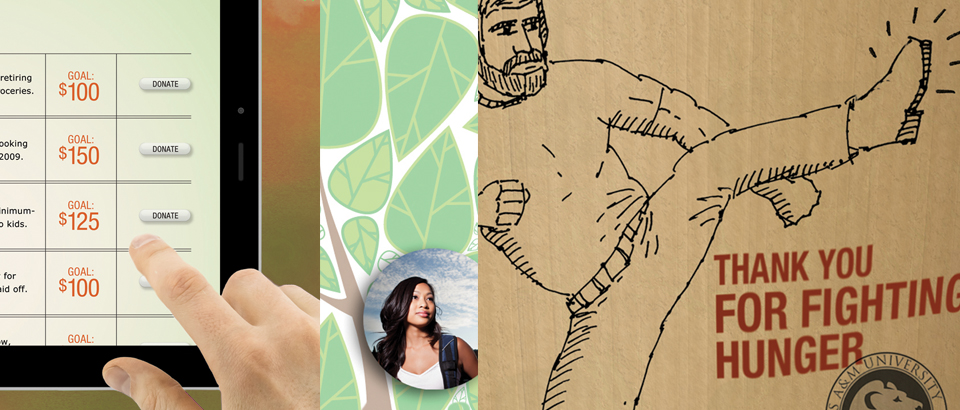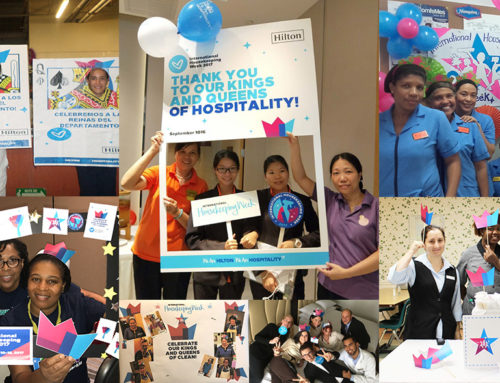For the past six years, RSW has developed awareness campaigns for the North Texas Food Bank intended to increase donations of food, time and money. Every year, individuals, companies, and organizations respond with their generosity.
As creative professionals, however, we like to ask questions. So, in 2010, as we were generating campaign ideas, someone asked, “What if we go outside our traditional donor audiences and talk specifically to younger people?” We knew that, someday, these young people would become adults who are deciding which non-profit to support. So, why not get them engaged now?
We really liked this idea. But, at the time, it didn’t fit our strategy. Sometimes, however, a good idea gets a second chance. As part of the Texas A & M Commerce MFA program I was completing, I needed a good topic for a thesis research project. With some exploration, the original idea was developed into a thesis study based on microdonations. The objective? Prove that promoting microdonations of $1-$5 to university students is a viable fundraising strategy for non-profits.
In my mind, this was simple. If the guys who developed Angry Birds could market a $3 app to young people and make millions, why couldn’t we ask this same group to donate $1-$5 to a food bank and use the power of their expansive on-campus and social networks to make an impact on the problem of hunger?
Interestingly, there hadn’t been much research combining microdonations with universities. But there were a couple of good stories. In 2009, LSU partnered with the Capitol Area United Way and raised $9000 during an LSU-Auburn basketball game. During a timeout, they simply asked audience members to donate $10 each through text-to-donate technology.*
In the spring of 2012, the microdonation study took place and included 117 students from Texas Christian University and Texas A & M Commerce. As a starting point, a survey gathered their opinions about microdonations, food banks, and the general idea behind the study. Luckily, a majority of the students also liked this idea.
Next, existing research on donor motivations was used to develop five concepts for promoting microdonations within the university environment. The concepts were presented to students in a video format and included the following:
- The Donation Tree Website encourages students to start or join a mini fundraising campaign and invite their friends.
- The Childhood Hunger Website allows young donors to purchase collectables featuring drawings from kids who benefit from their donations.
- Small Campaigns at School Events uses display monitors to track text-to-donate mini campaigns before school events.
- Fight Hunger Day brings together 100,000 students from local schools in a one-day, text-to-donate fundraising competition.
- Donation Coffee Sleeves promotes $1 donations within foodservice environments.
The results were surprisingly positive. 79 percent of the students said they would make a microdonation to a food bank, even before seeing any of the ideas.
For all five of the ideas presented, more than 50 percent of the respondents said they would make a microdonation, with The Donation Tree Website having the highest score at 80 percent.
Additionally, a majority of the students said they would share all five donation opportunities with friends. In fact, of the students who said they would not make a donation based on any idea, 30 percent of those students would still share those opportunities with others. More than anything, this underscores the strength of social networks within this group.
This study was really just a small sampling of the potential for this strategy, based mostly on our experience with the North Texas Food Bank. To see its true potential, communications could be expanded to a national or even international audience of students. With all the current heated conversations about rising tuition costs, student debt, and the true value of higher education, maybe there’s a bright spot we can focus on. What students lack in funds, they make up for in social influence. And maybe that can be used for good.
The complete thesis paper for this study, “Microdonations Strategies for University Environments” is available for download online. An overview of this study, the microdonation concepts and the exhibit featured at Texas A & M Commerce can also be viewed as a video.
Sources:
* Joos, Stephen. “Case Study: Using Mobile Donations at In-Stadium College Events.” mgive.com. 12 Nov. 2009.





